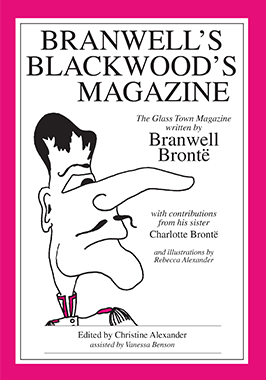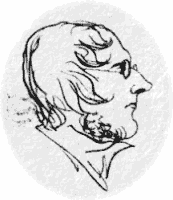Title of the work
Country of the First Edition
Country/countries of popularity
Original Language
First Edition Date
First Edition Details
Patrick Branwell Brontë, Branwell's Blackwood's Magazine. The Glass Town Magazine (with contributions from his sister Charlotte Brontë). Illustrated by Rebecca Alexander. Edited by Christine Alexander with Vanessa Benson, Edmonton, Canada: The Juvenilia Press, 1995, 44 pp. (written 1829 in the United Kingdom).
ISBN
Genre
Juvenilia*
Target Audience
Crossover (children (10+) and adults )
Cover

Cover courtesy of the publisher.
Author of the Entry:
Sonya Nevin, University of Roehampton, sonya.nevin@roehampton.ac.uk
Peer-reviewer of the Entry:
Susan Deacy, University of Roehampton, s.deacy@roehampton.ac.uk
Elżbieta Olechowska, University of Warsaw, elzbieta.olechowska@gmail.com

Self-portrait, 1840. Retrieved from Wikipedia, public domain (accessed: January 7, 2022).
Patrick Branwell Brontë
, 1817 - 1848
(Author, Illustrator)
Patrick Branwell Brontë, known as Branwell, was educated at home by his clergyman father, Patrick Brontë, learning classical languages and reading freely from the books and periodicals in his home. From an early age, Branwell and his sisters wrote stories based around the imaginary lives of a set of toy soldiers, known to them as 'The Young Men'. Branwell became a regular collaborator with his elder sister, Charlotte Brontë (1816–1855). They developed a complex society around 'The Young Men', located in a fictional colonial version of West Africa. Branwell had hopes of becoming a professional writer or painter. After receiving too few painting commissions, Branwell became a live-in tutor to a family. He was asked to leave; drunkenness and a fathering an illegitimate child (who died) have been suggested as the likely causes of his dismissal. He continued to try to forge a career as a writer, without success. He worked briefly for the railways, but was dismissed. He worked as a tutor in a second household. Another dismissal followed, this time in relation to a probable affair with the mother of his pupils. Branwell never ceased writing poems and stories and translating classical texts, but he died at his family home in 1848 of tuberculosis exacerbated by alcohol and opium abuse.
The History of the Young Men was never published in the Brontës' lifetime. It was edited by William Baker et al. for The Juvenilia Press, non-profit international initiative hosted by the Faculty of Arts and Social Sciences at the University of New South Wales dedicated to the juvenilia of significant writers.
Sources:
C. Alexander & M. Smith, The Oxford Companion to the Brontës, Oxford: Oxford University Press, 2006, 73–79;
sam2.arts.unsw.edu.au (accessed: March 24, 2020).
Bio prepared by Sonya Nevin, University of Roehampton, sonya.nevin@roehampton.ac.uk
Summary
The British authors, Charlotte, Emily, and Anne Brontë, whose novels included Jane Eyre (1847), Wuthering Heights (1847), and The Tenant of Wildfell Hall (1848), began their careers by writing elaborate juvenilia alongside their brother, Branwell. Together the sibling Brontë children created an imaginary society in West Africa – The Glass Town Federation, a union of four kingdoms and a federal capital – the Great Glass Town. They wrote extensively about that society, creating stories of its major events and its history, using multiple narrators and writing under the guise of multiple pseudonyms. Branwell Brontë created Branwell's Blackwood's Magazine when he was eleven and twelve. Three volumes of it survive, published together in this volume. The book opens with images of two of the original manuscripts' title-pages, complete with hand-drawn laurel wreaths. An introduction by Christine Alexander then details the context of the Magazine's composition.
Jan 1829 issue (pp. 1–4). This edition opens with a pseudo-scientific discussion of the fictional Kairail fish. Politically themed poetry follows, focused on the American Revolution. There is an account of a travel expedition.
June 1829 edition (pp. 5–20). The title-page of this edition features a central laurel wreath. A poem follows, Dirge of the Genii, discussing the genii's apparent disappearance. There is an extract of a story by Charlotte Brontë, The Enfant, which is told in full at the rear of the volume (pp. 42–44). A letter to the editor gives a fictionalised account of an event in the children's real lives – Charlotte's gift to Branwell of a copy of Ossian. This is presented as an announcement to the community of the Glass Town Federation (announcement: Chief Genius Taly has given Genius Bany Poems of Ossian: "I am fully convinced that it is the work of OSSIAN who lived 1000 years ago" (p. 12). The letter's purpose is to inform learned men of Glass Town that the poems have arrived in the Federation and that the author of the letter thinks the contents genuine, and to give notice of the date at which he means to have an edited volume of the poems available for purchase.
A play titled, Nights follows (pp. 14–19). It depicts a meeting to foster rebellion against the tyranny of the Genii, followed by a discussion of Ossian. The play's characters include "Epaminondas Johnson" and "Cicero Stephenson" (p. 14). The Latin form, Omnes 'all' is used when all the characters speak at once. This 1995 edition features an illustration of Chief Genius Taly depicted as an Olympian god, holding a copy of Ossian (p. 18).
Jul. 1829 edition (pp. 21–34). The title page, with laurel wreath, is reproduced. Nights continues (pp. 23–30). A Genius appears from the fire and rebukes them for disturbing him by throwing something in the fire. He intends to kill them all. They frighten him off by throwing a magic substance in the fire. They discuss Ossian further. Branwell supplies explanatory notes. The script is followed by a modern image of Chief Genius Banny as an Olympian god, holding a staff and a lightning bolt (p. 30).
An uncomplimentary review of Bud's Commentary on Ossian follows. A passage is cited accompanied by a note: "The thistle: latin Carduus; Greek σκολυμος; a prickly weed abounding in Scotland" (p. 31). There is a short gothic story by the Federation's historian, Captain Bud. There is a notice of a book to be published, by (fictional author) Moses Chateaubriand, "Author of Travles in Greece and the Holy land" (sic, p. 41 with n. 5). There is a further notice that Chief Genius Charlotte will take over editorship, "ΔΘΗ". The modern editors suggest (n. 54) that "ΔΘΗ" does not mean anything, but is Branwell "displaying his knowledge of the Greek letters". One might add that his imitation of a classical abbreviation is done to add an air of solemnity and authority. Some amusing adverts conclude the work.
Analysis
Branwell's Blackwood's Magazine is an imitation of the real Blackwood's Magazine, to which their father, Rev. Brontë, was a subscriber. The magazine featured fiction and non-fiction, prose and poetry, with discussions and accounts of exploration, military campaigns, political news, and literary criticism, including debate over the celebrated Ossian, pseudo-Gaelic poet (see Introduction p. xi). The publication had also featured extensive discussions of classical texts including the lively debate on the nature of the Homeric epics. The variety of material in Branwell's magazine thus reflects the variety found in the original. Branwell's editions were tiny, the first only 5.4–3.5 cm (p. viii). Their diminutive size suited them to the toy soldiers who inspired the events in the Glass Town Federation, although sourcing paper was always a difficulty for the children. The size is also a reminder of the intended readership of the magazine – the imaginary adults of Glass Town and, perhaps to a lesser extent, Branwell's (child) sisters.
Through the use of laurel wreaths and Greek letter pseudo-abbreviations, Branwell adds classical detailing that emulates the classicisms of the real Blackwood's Magazine, attempting to establish an air of learning and erudition. The discussion of the fictional, monstrous Kairail fish also appears to draw on classical material. It is said to be blue, and the editor notes (n. 2) that 'caerul(e)us' is 'blue' Latin, used to describe a monstrous snake in the Aeneid (Virgil, Aeneid, 2.381), a Latin work that Branwell is known to have been studying with his father, and which also features "two monstrous crested sea-snakes... (2.199–211) [which] may have inspired the Kairail fish" (p. xii).
Several of the magazine's contributions are concerned with the Genii, the Olympian-like figures who represent the Brontë children as creators and who take a direct role in the action of the stories. The introduction alerts the reader to the Olympian nature of the Genii (p. ix), while the (modern) illustrations explore this further by depicting Branwell and Charlotte's Genii personae in an Olympian form. This supports the modern reader in their conception of the Genii as figures created with classical deities at least partly in mind. At this stage in the Glass Town Saga, the inhabitants view the Genii with some hostility, regarding them as cruel tyrants. This demonstrates Branwell's perception of the Olympians as ambiguous figures and furthermore helps him to articulate his interpretation of (near)-contemporary discussions about both political and divine power.
The play, Nights, was based on Noctes Ambrosianae, a series of c. 70 imaginary discussions published in the real Blackwood's (n. 21). Branwell chose the names of real historical figures to provide some of the names for the plays – Epaminondas and Cicero. This seems playful rather than anything else; the characters in the play do not particularly reflect qualities associated with those two figures. Nonetheless, this is an example of Branwell using classical material to add vibrancy and perhaps erudition to his writing, and a minor reflection of his practice of drawing on his classical learning for inspiration in his imaginative play and creative writing.
Ossian was thought to be an ancient Gaelic writer, although the poems published under that name were revealed to be fraudulent. As early as the latter part of the eighteenth-century many were arguing that they were not what they appeared, although a letter in Blackwood's in 1821 continued the debate arguing that they were 'sublime' whether genuine or not (n. 19). Their prominence in the magazines suggest that Branwell was very much taken with both Ossian's poetry and with the perception of them as special ancient works. His inclusion of this material also demonstrates his engagement in discussions amongst scholars on the nature of ancient texts and how textual criticism might be applied. Whether Branwell engaged in the lost issues with the debate on the nature of the Homeric epics is a question likely to go unanswered.
There is not a great deal of classical material in Branwell's Blackwood's Magazine, yet it is noteworthy that what material there is is all-pervasive, appearing in all three editions and in items from all manner of genres. It so pervades Branwell's sense of what appears in a magazine and how one should express oneself as a writer that it is part of his incidental material (title-pages), his poems, scientific work, literary criticism, plays, and travel writing. For him, classical learning is fundamental to the sense of being knowledgeable and it is central to his conception of himself as a writer and intellectual figure that he express himself in a way that demonstrates his mastery of that cultural language.
Further Reading
Alexander, Christine, The Early Writings of Charlotte Brontë, Oxford: Blackwells, 1983;
Alexander, Christine, "Readers and Writers: Blackwood's and the Brontës", The Gaskell Society Journal 8 (1994): 54–69;
Alexander, Christine and Smith, Margaret, The Oxford Companion to the Brontës, Oxford: Oxford University Press, 2003;
Juvenilia Press (accessed: March 24, 2020).
Addenda
Greenberg, Isabella, Glass Town, London: Jonathan Cape, 2020.


